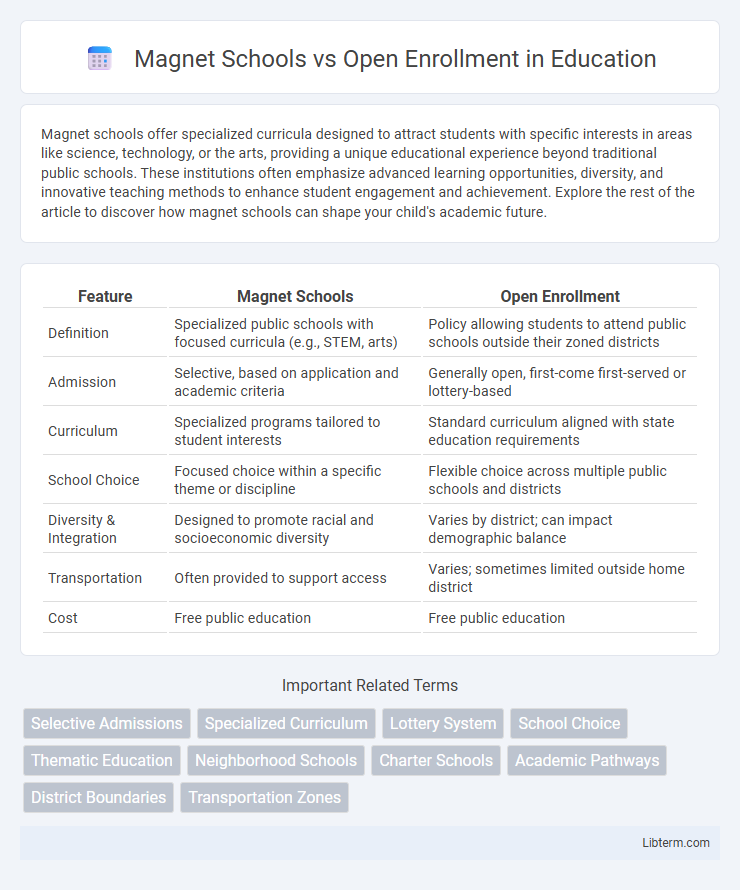Magnet schools offer specialized curricula designed to attract students with specific interests in areas like science, technology, or the arts, providing a unique educational experience beyond traditional public schools. These institutions often emphasize advanced learning opportunities, diversity, and innovative teaching methods to enhance student engagement and achievement. Explore the rest of the article to discover how magnet schools can shape your child's academic future.
Table of Comparison
| Feature | Magnet Schools | Open Enrollment |
|---|---|---|
| Definition | Specialized public schools with focused curricula (e.g., STEM, arts) | Policy allowing students to attend public schools outside their zoned districts |
| Admission | Selective, based on application and academic criteria | Generally open, first-come first-served or lottery-based |
| Curriculum | Specialized programs tailored to student interests | Standard curriculum aligned with state education requirements |
| School Choice | Focused choice within a specific theme or discipline | Flexible choice across multiple public schools and districts |
| Diversity & Integration | Designed to promote racial and socioeconomic diversity | Varies by district; can impact demographic balance |
| Transportation | Often provided to support access | Varies; sometimes limited outside home district |
| Cost | Free public education | Free public education |
Understanding Magnet Schools: Definition and Purpose
Magnet schools are public schools with specialized curricula designed to attract a diverse student body from across traditional school zones, focusing on themes such as science, technology, or the arts. Their primary purpose is to promote academic excellence and foster racial and socioeconomic integration by offering unique educational programs not typically available in standard public schools. Unlike open enrollment policies that allow students to attend any school within a district, magnet schools select students based on interest or aptitude related to their specialized programs.
Overview of Open Enrollment: What Does It Mean?
Open enrollment allows students to attend public schools outside their designated district boundaries, providing families with greater choice in education options. This policy enables access to specialized programs or higher-performing schools without residency restrictions, promoting educational equity. Enrollment procedures typically require application during specific periods and may involve lottery systems if demand exceeds capacity.
Admission Processes: Magnet Schools vs Open Enrollment
Magnet schools utilize a selective admission process based on academic achievements, talents, or specific themes such as STEM or the arts, often requiring applications, tests, or auditions to ensure alignment with the program's focus. Open enrollment policies allow students to attend schools outside their zoned area without selective criteria, typically following a lottery or first-come, first-served system when demand exceeds available spaces. The key difference lies in magnet schools prioritizing specialized criteria for admission, while open enrollment emphasizes accessibility and parental choice across public schools.
Curriculum and Program Differences
Magnet schools offer specialized curricula focused on themes like STEM, performing arts, or International Baccalaureate programs, designed to foster advanced skills and talents in specific areas. Open enrollment allows students to attend schools outside their zoned district but typically follows the standard curriculum provided by the receiving district without additional thematic specialization. Emphasizing curriculum, magnet schools provide enriched, theme-based learning environments, whereas open enrollment prioritizes broader access to existing educational programs.
Diversity and Student Demographics
Magnet schools attract a diverse student population through specialized programs that emphasize academic rigor and unique curricula, often leading to increased racial and socioeconomic integration compared to traditional public schools. In contrast, open enrollment policies allow families to choose schools outside their residential zones, which can either enhance or limit diversity depending on regional demographics and transportation accessibility. Studies show magnet schools generally achieve higher levels of student diversity and demographic balance, promoting inclusive educational environments.
Academic Performance and Outcomes
Magnet schools consistently demonstrate higher academic performance due to specialized curricula and selective admission processes that attract motivated students and experienced educators. Open enrollment policies increase school choice but show varied academic outcomes since they allow a broader demographic with diverse achievement levels to attend different schools. Studies indicate magnet school students often outperform their open enrollment counterparts in standardized test scores, graduation rates, and college readiness metrics.
Transportation and Accessibility
Magnet schools often provide transportation services within designated zones to enhance accessibility for specialized programs, attracting diverse student populations from various districts. Open enrollment policies generally depend on district resources and may lack consistent transportation options, potentially limiting accessibility for students residing farther from preferred schools. Ensuring reliable transportation is critical in both models to promote equitable access and maximize educational opportunities.
Extracurricular Opportunities
Magnet schools often provide specialized extracurricular opportunities aligned with their themed curricula, such as STEM clubs, performing arts, or language immersion programs, enhancing student engagement beyond academics. Open enrollment policies allow students to attend schools outside their zoned districts, potentially offering access to a wider variety of extracurricular activities based on the resources and focus of the chosen schools. Families prioritizing diverse extracurricular options should consider the specific programs available through both magnet schools and open enrollment districts to maximize students' skill development and interests.
Parent and Student Perspectives
Parents value magnet schools for their specialized curricula and rigorous academic programs that cater to students' unique interests and talents, often leading to enhanced student engagement and achievement. Open enrollment policies appeal to families seeking flexibility and choice in public education, allowing students to attend schools outside their designated zones, which can improve access to diverse programs and better school environments. Both options provide parents and students with pathways to tailor education, but concerns about transportation, application competitiveness, and equity impact decision-making.
Choosing the Best Option: Key Factors to Consider
Choosing between magnet schools and open enrollment involves evaluating factors such as specialized curriculum availability, student interests, and commute feasibility. Magnet schools offer focused programs in areas like STEM or the arts, enhancing academic engagement for students with specific talents or aspirations. Open enrollment provides broader choice across various public schools, enabling families to select environments best suited to their child's social and academic needs without geographical restrictions.
Magnet Schools Infographic

 libterm.com
libterm.com